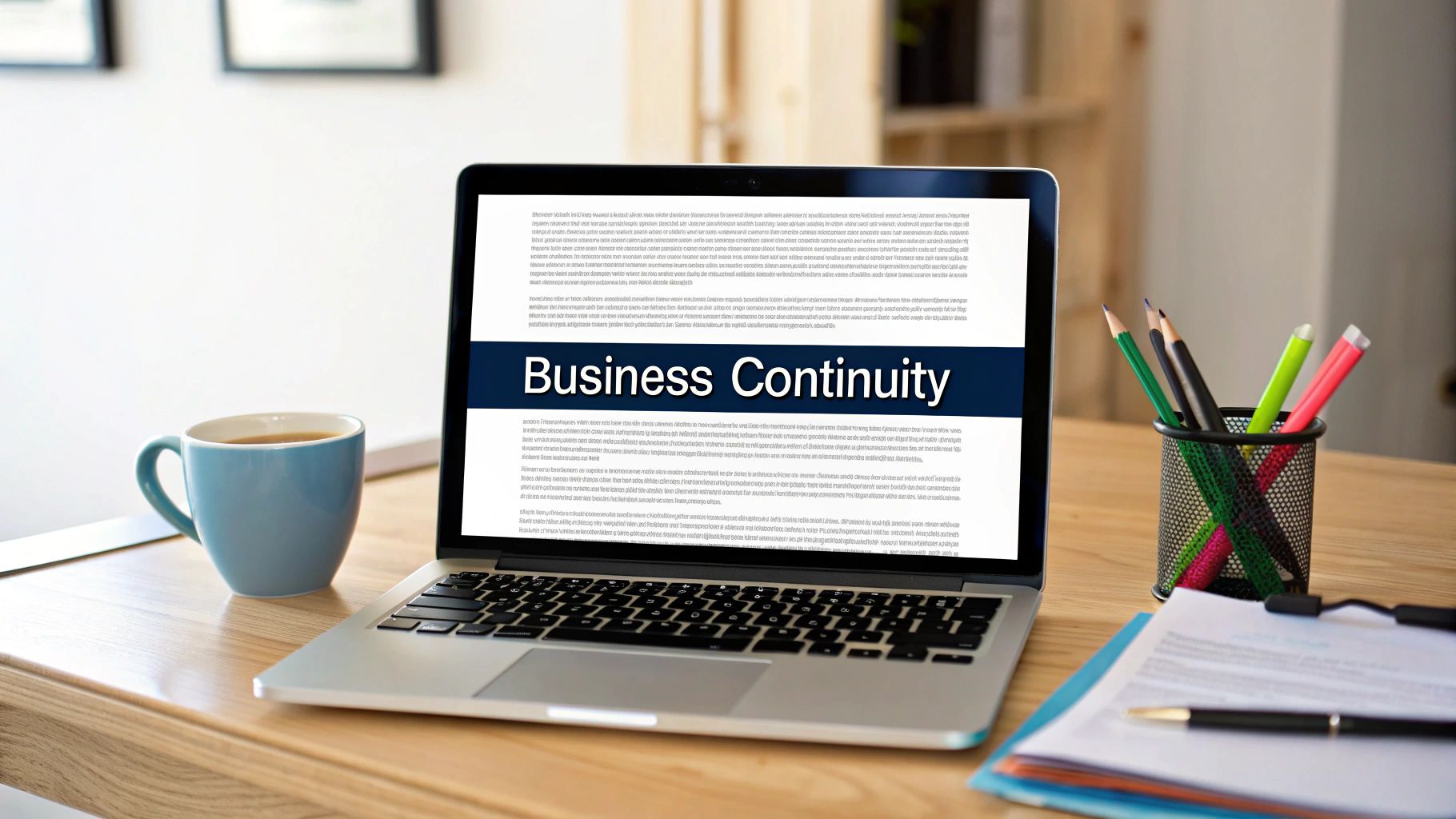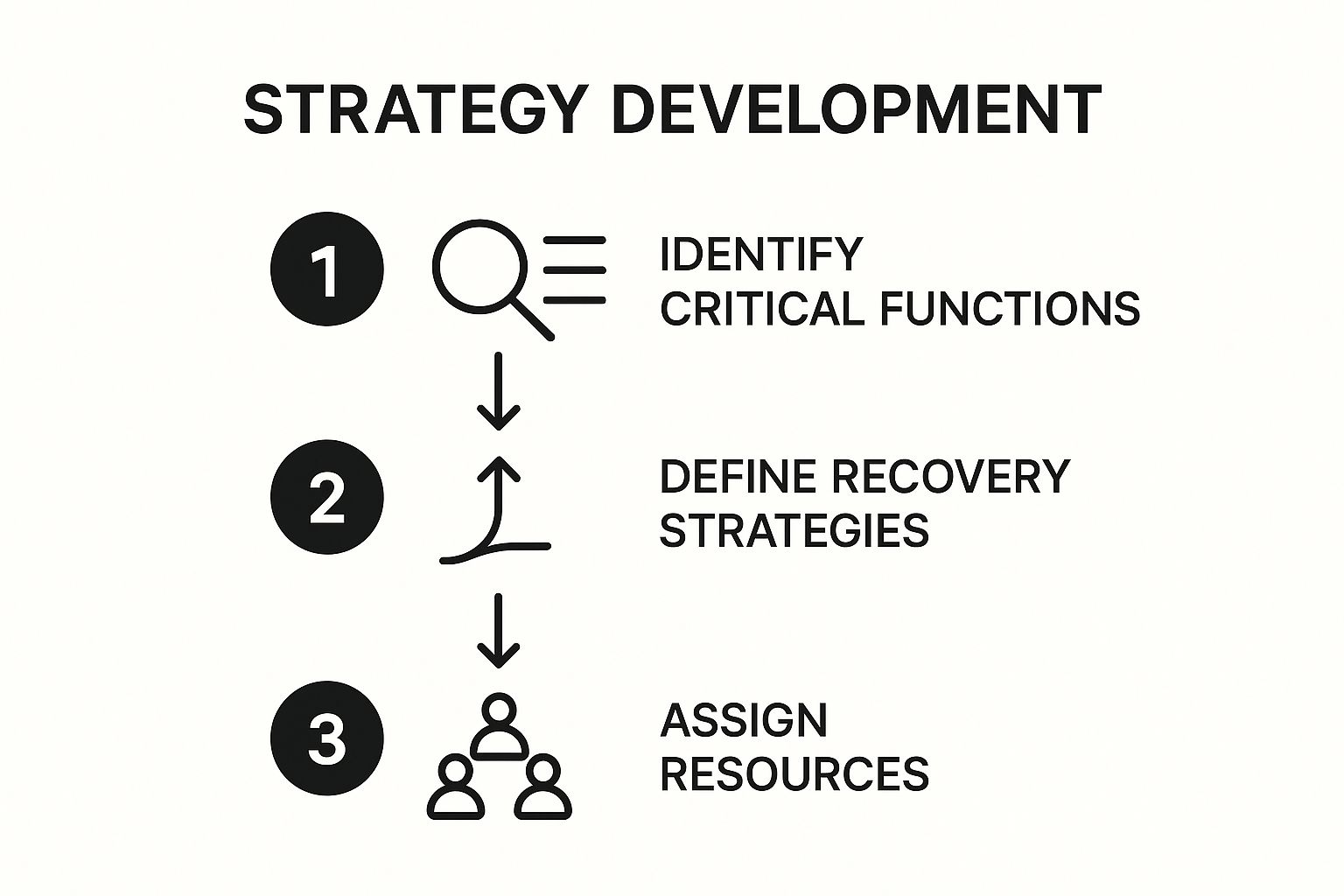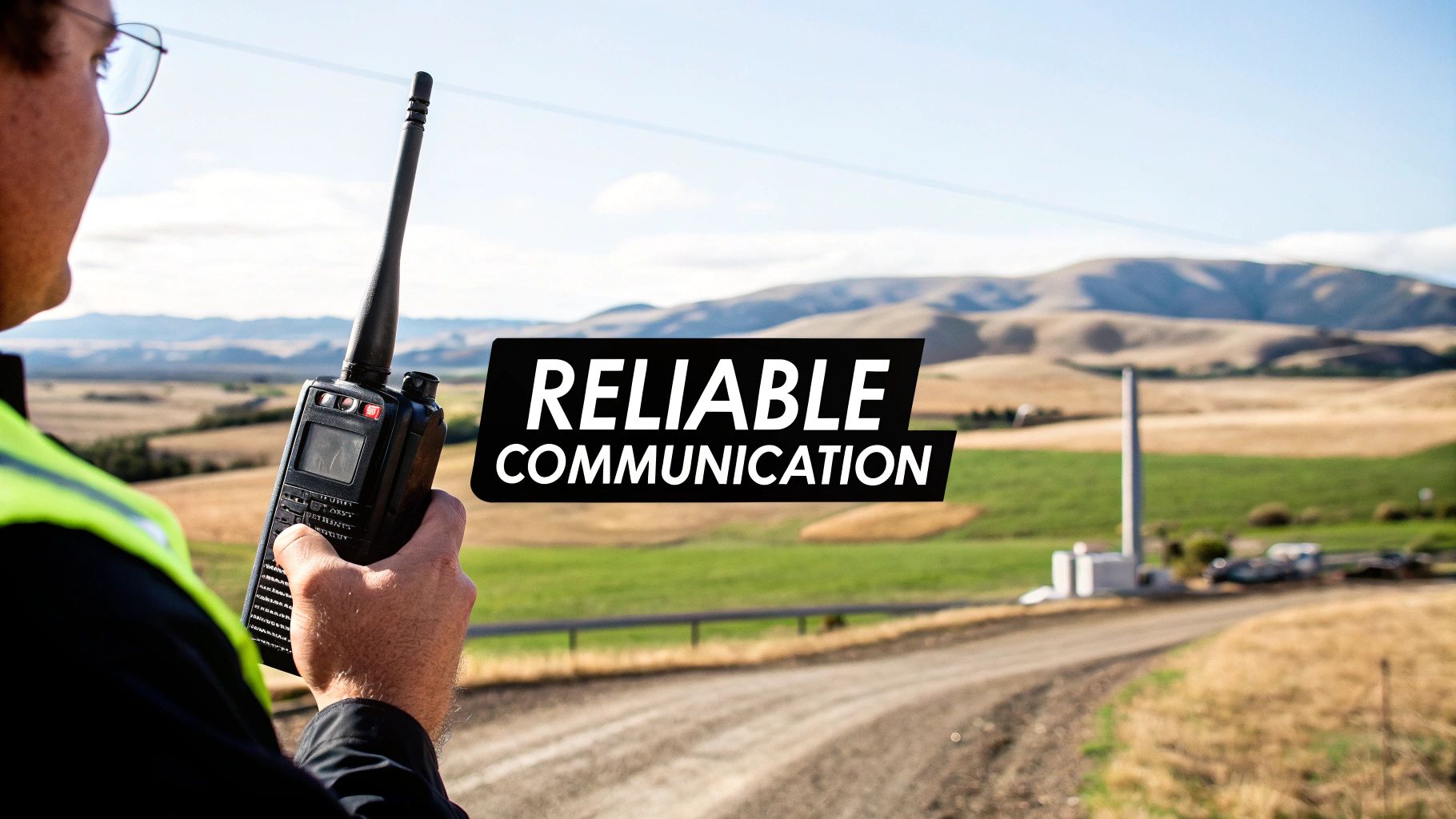Download Our Business Continuity Plan Template – Stay Prepared
A solid business continuity plan is more than just another document you file away. Think of it as a lifeline, a pre-written strategy that guides your entire organisation through a crisis. For any New Zealand business, this means having a clear path forward to handle everything from another big quake to a sudden cyber attack, ensuring you can keep operating and hold onto the customer trust you've built.
Why Your NZ Business Needs a Continuity Plan Now

Trying to navigate a crisis without a plan is a gamble no Kiwi business can afford to take. Here in New Zealand, it's never a question of if a disruption will hit, but when. A business continuity plan (BCP) is your playbook for resilience, helping you move past simply surviving a crisis to bouncing back even stronger.
A good business continuity plan template gives you the framework. Your job is to fill it with practical, actionable steps that make sense for our unique environment. This isn't just about preparing for a worst-case scenario; it's about protecting your team, your assets, and the hard-won relationships you have with your customers, underpinned by a legally compliant communications strategy.
The Unique Challenges Facing Kiwi Businesses
New Zealand’s distinct geography and economy throw a specific set of challenges our way. While businesses everywhere face threats like digital security breaches or supply chain failures, Kiwi businesses have an extra layer of environmental risk to contend with.
Our vulnerability to natural disasters is a massive driver for needing a comprehensive BCP. We’ve seen time and again how exposed local businesses are. The 2011 Christchurch earthquake, for example, caused an estimated NZ$40 billion in economic damage. More recently, the 2023 Auckland floods resulted in over NZ$1.5 billion in insurance claims in just a few weeks, showing just how fast the financial fallout can stack up.
These events don't just damage buildings. They cut off supply lines, take out communication networks, and leave staff unable to work, making recovery a monumental task if you don't have a plan ready to go.
A business continuity plan does more than prepare you for disasters; it demonstrates to your clients, investors, and staff that you are a reliable and forward-thinking organisation, capable of weathering any storm.
Moving Beyond Survival to Strategic Resilience
It’s a common mistake to think a BCP is only about disaster recovery. While that’s a huge part of it, a modern plan is much more proactive. It's a living strategy that actually strengthens your day-to-day operations and builds organisational muscle.
Working through continuity planning forces you to identify your most critical business functions. What absolutely has to keep running for you to serve customers and bring in revenue? That simple question is the bedrock of a truly resilient business.
- Protecting Your People: A BCP puts the safety and wellbeing of your employees first. It lays out clear communication protocols so everyone knows exactly what to do in an emergency. This goes hand-in-hand with having solid workplace safety procedures in place, creating a complete culture of safety.
- Maintaining Customer Trust: When a crisis hits, radio silence is the worst thing you can do. Your BCP needs a communication strategy to keep customers in the loop, manage their expectations, and maintain their confidence in your brand.
- Securing Your Operations: From data backups to having alternative suppliers lined up, your plan identifies the redundancies that will keep the wheels turning. This must include access to legally compliant and reliable communication devices that work when standard networks are down—a critical piece of the puzzle in New Zealand.
By using a business continuity plan template, you aren't just ticking a box for a hypothetical disaster. You're making a direct investment in the long-term stability and success of your business, turning potential weaknesses into real strategic strengths.
Conducting a NZ-Specific Risk Assessment

Before you can even think about writing your plan, you need to get a really clear picture of what you’re up against. A solid risk assessment is the bedrock of any good business continuity plan template. This isn't about plucking ideas out of thin air; it’s a systematic process of figuring out what could realistically knock your business sideways and understanding the potential fallout.
For any Kiwi business, this means looking beyond the usual global threats. Sure, things like data breaches and gear failure are universal problems. But our local context here in New Zealand adds its own unique flavour. We have to be ready for anything from a major shake that cuts off our supply lines to a regional flood that shuts down roads for weeks.
Identifying Your Critical Business Functions
First things first, you need to do a Business Impact Analysis (BIA). It sounds a bit technical, but the idea is simple: pinpoint the absolute must-have processes that keep your business running. These are the functions that, if they stopped, would cause the most immediate and severe damage to your revenue, reputation, and customer relationships.
Have a good think about your core operations. What activities directly bring in money or deliver value to your clients? If you run a transport company, it’s all about keeping the fleet on the road. For a packhouse, it's grading and shipping produce without interruption.
Ask yourself:
- Financial Impact: Which processes, if they stopped tomorrow, would turn off the cash-flow tap?
- Operational Impact: What are the non-negotiable functions for delivering your main product or service?
- Reputational Impact: Which activities are vital for keeping your customers' trust and protecting your brand?
By mapping these out, you’re essentially creating a priority list. This focuses your continuity efforts where they'll make the biggest difference, instead of trying to save everything all at once. It’s this focus that turns a BCP from a document that sits on a shelf into a genuinely practical tool.
Analysing NZ-Centric and Universal Risks
Once you know what your critical functions are, you can start identifying the specific threats they face. Here in New Zealand, that means wearing two hats—one for our unique environmental risks and another for the universal challenges every business deals with.
It really helps to break these risks down into categories to make sure you haven't missed anything obvious.
NZ Environmental Risks
- Seismic Activity: Earthquakes causing building damage, power cuts, and major transport disruptions.
- Severe Weather: Think flooding, cyclones, or heavy snow that could isolate your premises or knock out key infrastructure.
- Volcanic Eruptions: Ashfall grounding flights and damaging sensitive electronics and machinery.
Universal Business Risks
- Cyber-Attacks: Ransomware, data breaches, or denial-of-service (DDoS) attacks that could paralyse your IT systems.
- Supplier Failure: A key supplier suddenly goes out of business or can't deliver the goods you depend on.
- Utility Outages: Losing power, water, or internet for an extended period.
- Pandemic or Health Crisis: Widespread illness leading to critical staff shortages.
When you're digging into the digital side of things, it can be really useful to reference a dedicated cybersecurity risk assessment template to get more granular on those specific threats.
Ranking Risks by Likelihood and Impact
Not all risks carry the same weight. The final piece of the puzzle is to prioritise them by figuring out how likely they are to happen and how much damage they could do. This is crucial for allocating your time and money effectively, letting you tackle the biggest and most probable threats first.
A simple scoring system works wonders here—try a 1-5 scale for both likelihood and impact. A risk that’s highly likely and would have a severe impact (like a key supplier failing for a manufacturing firm) gets a high score and needs immediate attention in your plan. On the other hand, a low-likelihood, low-impact risk can be noted but doesn't need an urgent, detailed plan.
This risk matrix isn't just an administrative task. It's a strategic map that guides every decision you make in your business continuity planning, from your communication plan to your recovery protocols. It’s what transforms your template into a customised, powerful shield for your business.
Structuring Your Team and Communication Strategy

A perfectly written business continuity plan template is useless if nobody knows what to do when a crisis hits. The real power of your plan comes from the people tasked with putting it into action and the communication channels that connect them. This is the human side of continuity, where clear roles and reliable communication become your most valuable assets.
When things go wrong, you need people to step up and act decisively, not stand around wondering who’s in charge. Without a well-defined team structure, chaos takes over fast. Defining roles beforehand ensures a coordinated, effective response when every second counts.
Building Your BCP Response Team
First things first: you need to assemble a dedicated BCP response team. This isn't just about picking senior managers. It's about choosing people for their skills, their knowledge of specific business areas, and their ability to stay calm under pressure. Each member needs a clearly defined role with explicit responsibilities.
Think of it like a crew on a ship navigating a storm. Everyone has a specific station and a job to do, all coordinated by a captain.
Your core BCP team should include:
- Crisis Leader: The overall commander who makes the final calls and authorises activating the BCP. This person needs a complete, bird's-eye view of the business.
- Departmental Contacts: People from key areas—like operations, finance, IT, and HR—who are responsible for executing the plan within their department.
- Communications Lead: The person in charge of managing all internal and external messages, ensuring a consistent and clear voice.
- IT/Technical Lead: The expert responsible for assessing and restoring technology, data, and critical communication systems.
It’s also vital to assign backups for every single role. What happens if your main Crisis Leader is unreachable during a regional power cut? Who’s next in line? This redundancy is a non-negotiable part of a workable plan.
Unbreakable Communication Lines for NZ Conditions
Your standard communication tools like mobiles and email are great—until they’re not. During a major event in New Zealand, like an earthquake or a big storm, cell networks can get congested or go down completely. Your BCP must account for this with backup, legally compliant communication solutions.
Your communication strategy needs to operate on the assumption that normal infrastructure will fail. This means having tools that work independently of the usual networks.
A critical mistake is assuming your everyday communication tools will be available during a crisis. True resilience comes from having secondary and tertiary systems ready to deploy, especially those that don't rely on the local power grid or cellular towers.
For deeper insights into building a robust communication framework, understanding essential communication types can really strengthen your strategy.
NZ-Ready Communication Tools for Your BCP
In New Zealand, this means considering options purpose-built for our unique and sometimes tough conditions. For instance, satellite phones offer a direct connection that bypasses terrestrial networks, making them invaluable for remote sites or when main centres are offline. A robust VHF/UHF radio network can also provide reliable, localised communication for coordinating teams on the ground, independent of public infrastructure.
| Communication Tool | Best For | Key NZ Advantage | Practical Considerations |
|---|---|---|---|
| Satellite Phones | Critical communication when all other networks fail. Essential for key leaders. | Bypasses local cell/landline networks, making it ideal for earthquake or storm scenarios. | Requires a clear view of the sky. Subscription plans and hardware can be costly. |
| VHF/UHF Radios | On-the-ground team coordination within a specific area (e.g., a worksite, a city block). | Independent of public networks. Rugged and reliable in tough physical environments. | Limited range. Requires a General User Radio Licence (GURL) from Radio Spectrum Management (RSM) for most business uses. |
| Secure Messaging Apps | Quick staff updates and check-ins, especially on low-bandwidth networks. | Must comply with NZ's Privacy Act 2020 for handling personal info. Some apps work well on patchy data. | Relies on some form of internet (Wi-Fi or cellular data), which may be unavailable. |
| Emergency Text Alerts | Mass, one-way communication to all staff or stakeholders. | Leverages the SMS network, which is often more resilient than mobile data during congestion. | Not suitable for two-way conversation. Best for short, critical instructions. |
When you’re looking at digital tools, secure messaging apps are essential, but you must make sure they comply with New Zealand's Privacy Act 2020. This means protecting the personal information of your staff and clients, even when you're in emergency mode. For radio use, most commercial operations will need to adhere to the General User Radio Licence (GURL) conditions set by Radio Spectrum Management (RSM), a part of MBIE.
Developing Your Crisis Communication Plan
Once your tools and team are set, you need a plan for what to say and who to say it to. This means creating a contact tree and pre-drafting your core messages.
A contact tree is a simple hierarchy that ensures information flows quickly through the organisation. It starts with the Crisis Leader, who contacts their core team. That team then contacts their direct reports, and so on, until everyone is reached. You absolutely must test this tree regularly to keep all contact details current.
Finally, pre-drafting messages saves precious time and reduces the risk of mistakes during a high-stress situation. Create templates for different scenarios and audiences:
- Staff Updates: Initial alerts, safety check-ins, and instructions on remote work or site closures.
- Client Communications: Acknowledging the disruption, managing expectations, and providing updates on service availability.
- Supplier & Partner Messages: Informing them of your operational status and coordinating changes to logistics or orders.
Having these messages pre-approved and ready to go allows your Communications Lead to focus on adapting the message to the live situation, rather than writing from scratch. This level of preparation is what transforms your team and technology into a truly effective crisis response machine.
Developing Practical Response and Recovery Protocols
This is where the rubber meets the road. Your abstract plans have to face the hard reality of a crisis, and that means moving from planning to doing. It's not about writing a huge manual that collects dust on a shelf; it’s about creating clear, simple, and actionable procedures your team can actually follow when they're under immense pressure. A solid business continuity plan template gives you the framework, but these specific protocols are what bring it to life.
These protocols need to cover what happens immediately, in the short term, and over the long haul of a disruption. Immediate actions might be as straightforward as evacuating the building during a fire alarm or locking down your data during a cyber attack. Short-term fixes could involve getting everyone working remotely, while long-term recovery is all about getting back to business as usual.
Differentiating Your Response to NZ-Specific Scenarios
Here in New Zealand, we face our own unique set of potential disruptions, so a one-size-fits-all response just won't cut it. Your protocols have to be tailored to the specific risk you're dealing with. The steps you take after a major earthquake in Wellington are going to be completely different from what’s needed for a ransomware attack on your servers.
For instance, an earthquake aftermath protocol would put these things first:
- Personnel Safety: Accounting for all your staff using tools that don’t rely on overloaded cellular networks. Think satellite phones or a pre-agreed check-in system, maybe even a dedicated social media group.
- Structural Assessment: Having a clear procedure for getting a qualified engineer to assess building safety before anyone is allowed back inside.
- Physical Asset Security: Securing damaged equipment and inventory to prevent any further loss or injury.
- Supply Chain Disruption: Firing up your contact list for alternative local suppliers and transport operators who might be outside the affected zone.
On the other hand, a major data breach protocol focuses on a completely different set of priorities:
- Immediate Containment: This is a technical job for your IT lead. They need to be able to instantly isolate affected systems from the network to stop the breach from spreading.
- Legal and Regulatory Reporting: You'll need to notify the Office of the Privacy Commissioner if personal information has been compromised. This is a requirement under the Privacy Act 2020.
- Forensic Analysis: Getting cybersecurity experts on board to figure out the scope and origin of the attack.
- Stakeholder Communication: Having carefully worded messages ready to go for your clients, explaining the breach, what data was affected, and the steps you're taking to protect them.
This infographic lays out the core flow for developing these tailored strategies, starting with what's important and then assigning the right resources.

As you can see, there's a clear progression. You can't figure out effective recovery strategies or assign resources until you’ve first identified the critical functions that need protecting.
Creating Easy-to-Implement Action Steps
The best protocols are brutally simple. When people are stressed, they don't have the brainpower to decipher complex instructions. Use checklists, flowcharts, and clear "if-then" statements.
Data Recovery Steps Your data is often your most valuable asset. Your recovery protocol shouldn't just say "restore backups"—it needs to detail the exact sequence.
- Assess the Damage: First, figure out what caused the data loss (e.g., hardware failure, file corruption, cyber-attack). You don't want to restore the problem along with the data.
- Activate Recovery Team: Get the key IT people and any third-party data recovery partners on the line.
- Prioritise Systems: Restore the most critical systems first, based on your Business Impact Analysis. Customer-facing applications almost always take precedence over internal admin tools.
- Test and Verify: Before you bring systems back online for everyone, test them thoroughly in an isolated environment to make sure the data is intact and everything works.
Supply Chain and Operational Pivots Your ability to adapt your operations on the fly is crucial. This could mean rerouting deliveries or finding new suppliers in a hurry.
A resilient supply chain isn't just about having a backup supplier; it's about having a pre-vetted, ready-to-go relationship with that supplier. This means contact details, credit terms, and logistics are already sorted.
It's also vital to have specific plans for critical operational failures. For example, a detailed Breakdown Procedure Download can guide immediate actions during transport disruptions, providing a perfect model for this kind of specific, actionable planning.
Maintaining Customer Communications During an Outage
How you communicate during a crisis can make or break your reputation. Your protocols must include a clear plan for keeping customers in the loop, even when you don't have all the answers.
- Initial Acknowledgement: Get a message out fast. A simple, "We're aware of an issue affecting our services and are investigating urgently" is far better than radio silence. Use pre-drafted templates for this.
- Set a Cadence for Updates: Let customers know when to expect the next update (e.g., "We'll provide another update within the hour"). And then stick to that schedule, even if the update is just, "We're still investigating."
- Provide Alternative Channels: If your main support line is down, direct customers to an alternative, like a specific social media page or a temporary phone number. This is where having redundant communication tools, like a satellite phone for key staff, becomes crucial for coordinating your response.
By creating these practical, scenario-specific protocols, you transform your business continuity plan from a theoretical document into a powerful toolkit for real-world resilience.
Bringing Your BCP to Life Through Testing and Updates
Once you’ve filled out your business continuity plan template, the real work begins. A plan that just sits on a shelf collecting dust isn’t just useless; it’s a dangerous liability. To turn that document into a genuine tool for resilience, you have to bring it to life with regular, rigorous testing and consistent updates.
This is the only way to find out what works on paper versus what actually holds up under real-world pressure. It’s during testing that you’ll uncover the flawed assumptions, the out-of-date contact numbers, and the procedural gaps that could completely derail your response when it matters most.
From Theory to Practice: Different Ways to Test Your BCP
Testing doesn’t always mean a full-scale, disruptive drill that brings operations to a halt. Here in New Zealand, a practical approach means scaling your tests to match your operational capacity and the specific risks you face. The goal is to build muscle memory within your team, so when a real crisis hits, their actions are second nature.
Different testing methods are designed to uncover different types of weaknesses.
-
Tabletop Discussions: This is often the simplest yet most effective place to start. Get your BCP team in a room, give them a specific scenario—like, "A major cyber-attack has locked our servers, and the attacker is demanding a ransom"—and have them talk through the plan step-by-step. It’s a low-stress way to check if everyone truly understands their roles and if the initial response protocols actually make sense.
-
Walk-throughs and Drills: This takes it a step further. Instead of just talking, you physically walk through a specific procedure, like an evacuation or activating your backup communication tools. For instance, can your team actually retrieve and operate the satellite phones? Do your VHF radios have charged batteries? A drill for your communication tree can be as simple as having the crisis leader send a test alert to their direct reports, who then pass it down the chain. You time how long it takes for everyone to confirm receipt.
-
Full-Scale Simulations: This is the most comprehensive test, where you mimic a real crisis as closely as you can. It might involve setting up a mock command centre, using backup systems, and having staff respond in real-time to evolving scenarios. For example, you could simulate an earthquake scenario where physical access to the office is blocked, power is out, and your team must activate remote work protocols and restore critical data from backups. This is also where you test physical security measures; you can review our guide on choosing a security camera system to see how physical surveillance integrates into a full simulation.
The Importance of a Regular Review Schedule
Testing reveals the gaps, but a formal review and update process is what closes them for good. In New Zealand, this isn't just a best practice; for many businesses, it’s a compliance requirement.
A BCP is a living document. It has to evolve with your business. If it reflects what your company looked like a year ago, it’s already out of date and potentially useless.
For example, firms listed on the NZX (New Zealand Exchange) are required by NZX Guidance Note to maintain and annually review their BCPs. They also need to conduct extra reviews after any significant change in business structure, location, or operations. The guidance is clear: it's not just about creating a BCP, but about regular testing. Best practice points to at least annual simulations, including mock drills and staff training.
A practical review schedule should include:
- Annual Review: A deep dive into the entire plan at least once a year.
- Post-Incident Review: After any disruption, big or small, analyse what went well and what didn't. This is invaluable information.
- Post-Change Review: Update your plan immediately after any significant business change, like opening a new branch, adopting new critical software, or changing a key supplier.
It's absolutely critical to gather feedback from everyone involved in a test or a real event. Use this feedback to refine your procedures, update contact lists, and improve communication strategies. This continuous loop of testing, feedback, and refinement is what builds true, lasting organisational resilience.
Frequently Asked Questions About BCP in New Zealand
Even with a solid business continuity plan template, it's natural for questions to pop up. This is especially true for Kiwi business owners who are dealing with our unique set of local challenges. Let's tackle some of the most common queries we hear to help you get your plan from a document on a hard drive to a living, effective strategy.
How Often Should My NZ Business Test Its BCP?
The textbook answer, which aligns with guidance from authorities like the NZX, is to run a major test at least once a year. But from our experience, the real magic happens with smaller, more frequent checks. These are what build genuine muscle memory in your team.
We recommend running quarterly tabletop exercises. It's as simple as getting your response team in a room to talk through a specific scenario. What if a key supplier suddenly goes out of business? What if a cyber-attack takes out your ordering system?
Walking through the BCP's steps in this low-stress way is brilliant for finding gaps you never knew you had.
Your full-scale drill—the one that might involve your whole team, backup systems, and maybe even a few key partners—can then be your big annual event. The most critical part? You absolutely must review and update your plan after any significant business change. That could be anything from moving office, to bringing in new critical software, or even just changing your main delivery company. This keeps your BCP from becoming a dusty file and turns it into a genuinely useful strategy.
What Are the Most Overlooked Risks for NZ Businesses?
It’s easy to focus on the big, obvious stuff like earthquakes and floods. But in New Zealand, there are three other risks that often fly under the radar and can be just as devastating.
- Supply Chain Concentration: This is a big one. It’s when you’re leaning too heavily on a single supplier, especially if they’re based in a high-risk area themselves. Imagine your one and only packaging provider gets knocked out by a regional flood – your entire operation could grind to a halt.
- Key Person Dependency: What’s the plan if one of your most vital team members is suddenly out of action for an extended period? For so many Kiwi SMEs, the knowledge locked inside one person's head is a huge vulnerability. If they're gone, it can create a massive operational black hole.
- Reputational Damage: A crisis isn’t just about downtime; it's about how you look to the public. Your BCP needs a rock-solid crisis communication plan. A poorly handled response can destroy customer trust, and that damage often lasts much longer than the initial event itself.
Your business continuity plan has to be honest about these internal and commercial weak spots. You need to assess them with the same rigour you apply to a natural disaster. A plan that ignores key person risk isn't a complete plan.
Where Can I Find a Free Business Continuity Plan Template for My NZ SME?
You're in luck – several fantastic New Zealand organisations offer free resources specifically for Kiwi businesses. The websites for the National Emergency Management Agency (NEMA) and Resilient New Zealand are brilliant places to start. They provide guides and templates that are already tuned into our local context.
Don't forget to check with your local Chamber of Commerce, too. They often have resources that are even more tailored to your specific region. These templates are a great launchpad, giving you a solid structure to build from.
But—and this is important—they are just a starting point. You can't just download one and tick a box. You have to put in the time to do your own risk assessment and customise every single section to fit your business. Only by adapting it to your unique operations, communication channels, and likely threats will you create a plan that genuinely protects what you’ve built. For more answers, you can also check out our general FAQs page for further insights.
When a crisis takes out normal communication lines, having a reliable backup isn't a luxury—it's essential. Mobile Systems Limited specialises in providing rugged, dependable communication solutions like satellite phones and VHF/UHF radios that keep your team connected when it matters most. Explore our range of products and services at https://mobilesystems.nz to build a truly resilient communication strategy for your business.


